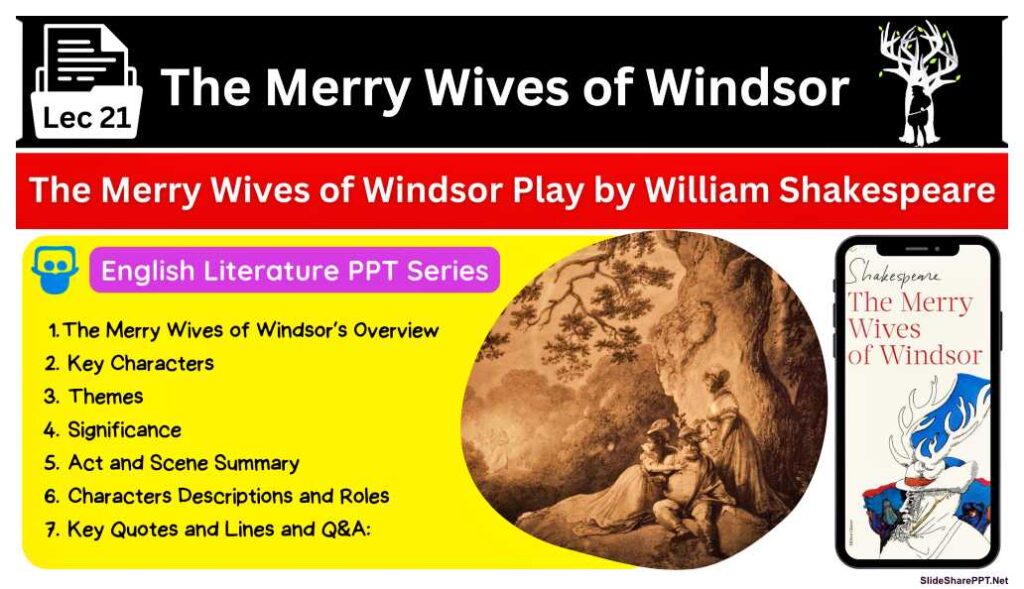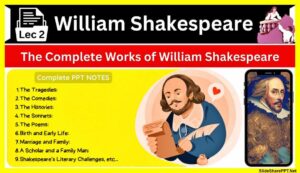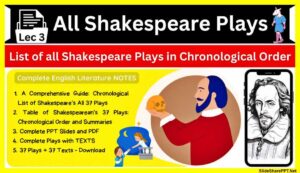The Merry Wives of Windsor PPT Slides & PDF Download
Contents
- 1 The Merry Wives of Windsor PPT Slides & PDF Download
- 1.1 About The Merry Wives of Windsor
- 1.2 The Merry Wives of Windsor PPT Slides
- 1.3 (Lecture 21)
- 1.4 The Merry Wives of Windsor Play by William Shakespeare
- 1.5 Key Characters
- 1.6 Themes
- 1.7 Significance
- 1.8 Act and Scene Summary
- 1.9 Characters Descriptions and Roles
- 1.10 Key Quotes and Lines
- 1.11 Q&A:
- 1.12 MCQ:
Today we have shared the Notes of William Shakespeare’s Famous Play The Merry Wives of Windsor PPT Slides & PDF Download, So as we know William Shakespeare, known for his timeless plays and intricate characters, gifted the world with a comedic gem in “The Merry Wives of Windsor.” Written in the late 16th century, this play showcases Shakespeare’s unparalleled wit and keen observation of human nature, all woven into a delightful tapestry of love, jealousy, and mischief. Let’s delve into the enchanting world of “The Merry Wives of Windsor” and explore its enduring appeal.
About The Merry Wives of Windsor
Here’s a complete table for “The Merry Wives of Windsor”:
| Aspect | Description |
|---|---|
| Title | The Merry Wives of Windsor |
| Playwright | William Shakespeare |
| Genre | Comedy |
| Date of Composition | Estimated to be between 1597 and 1601 |
| Setting | Windsor, England |
| Main Characters | Sir John Falstaff, Mistress Ford, Mistress Page, Anne Page, Fenton, Ford, Page, Shallow, Slender, Evans, Pistol, Bardolph, Nym |
| Plot Overview | The play follows the misadventures of Sir John Falstaff as he attempts to seduce two married women, Mistress Ford, and Mistress Page, in order to gain access to their husband’s wealth. However, the cunning wives outwit Falstaff with humorous and elaborate schemes. Meanwhile, various subplots involving young love and mistaken identities unfold, leading to a series of comic misunderstandings and reconciliations. |
| Key Themes | Marriage and fidelity, deception and trickery, social class and status, jealousy and revenge |
| Significance | “The Merry Wives of Windsor” is one of Shakespeare’s most light-hearted and farcical comedies, characterized by its lively humor, witty dialogue, and memorable characters. It is unique among Shakespeare’s plays as it is set entirely within the middle-class society of Windsor. |
| Notable Lines | – “Why, then the world’s mine oyster, / Which I with sword will open.” (Act 2, Scene 2) – “I cannot tell what the dickens his name is.” (Act 3, Scene 2) – “We’ll leave a proof, by that which we will do, / Wives may be merry, and yet honest too.” (Act 4, Scene 2) |
| Adaptations | Various stage productions, film adaptations, and television adaptations have been made over the years. Notable adaptations include the BBC Television Shakespeare series (1982) and stage productions by the Royal Shakespeare Company and other theater companies. |
This table provides a comprehensive overview of various aspects of “The Merry Wives of Windsor,” including its background, plot, characters, themes, significance, notable lines, and adaptations.
The Merry Wives of Windsor PPT Slides
(Lecture 21)
Important:-
- If you are viewing this PPT on your phone, please make it full screen and then view it. (Press: 3 dots in PPT, then Full Screen)
- If you have a problem while clicking on next, (Just tap) on the slide instead of clicking Next Botton.
- FOR A BETTER VIEW PRESS Ctrl + Shift + F ON A PC OR LAPTOP.
- Whatever is written in the PPT is different and whatever is written below is different.
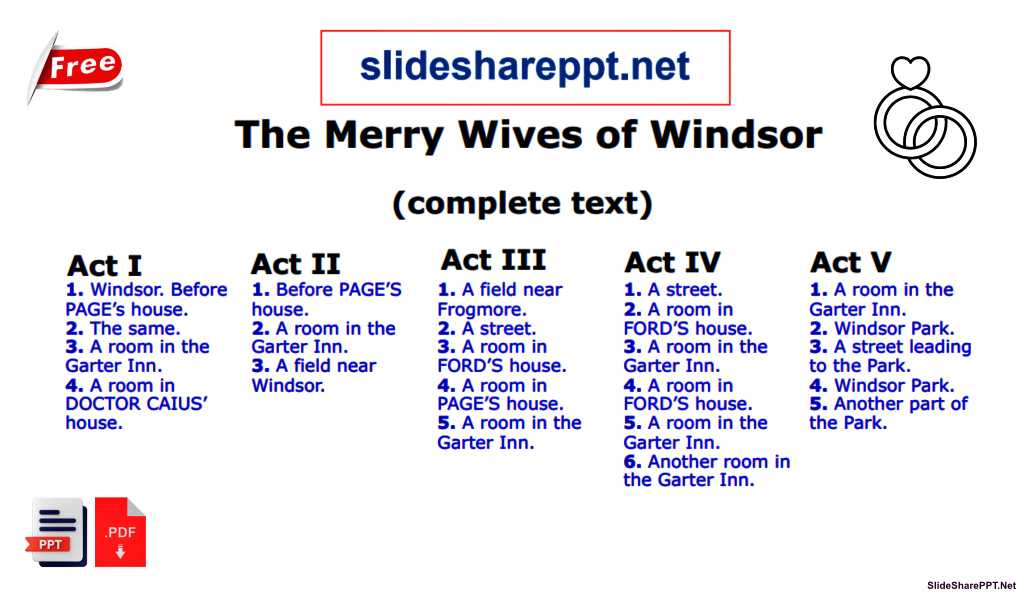
Note: The complete Text PDF Link is at the end of the PowerPoint slides (go to the last PPT Slide)
The Merry Wives of Windsor Play by William Shakespeare
“The Merry Wives of Windsor” by William Shakespeare is a comedic play set in the quaint town of Windsor, England. The story revolves around Sir John Falstaff, a boisterous and boastful knight, who devises a plan to seduce two wealthy married women, Mistress Ford and Mistress Page, in hopes of obtaining their wealth. Unbeknownst to Falstaff, the two women quickly discover his intentions and decide to teach him a lesson.
- Mistress Ford and Mistress Page, the titular “merry wives,” devise a series of humorous schemes to outwit Falstaff. They make plans to receive Falstaff’s advances, only to deceive and embarrass him. Meanwhile, Anne Page, the daughter of Mistress Page, is pursued by several suitors, including Dr. Caius and Fenton. Despite her parents’ attempts to arrange a marriage for her, Anne’s heart belongs to Fenton, and she rejects her parents’ choice of husband for her.
- Falstaff’s attempts to woo Mistress Ford and Mistress Page lead to increasingly elaborate and comical situations. He falls victim to the women’s schemes as he is deceived and humiliated multiple times. Meanwhile, Anne Page’s romantic entanglements come to a head as her parents attempt to arrange a marriage for her against her wishes.
- Meanwhile, Mistress Page’s daughter, Anne, is pursued by several suitors, including the French physician Dr. Caius and the young gentleman Fenton. Mistress Page prefers Dr. Caius as a potential suitor, while Mistress Ford favors Fenton. However, Anne’s heart belongs to Fenton, leading to a series of romantic entanglements and misunderstandings.
- As Falstaff’s schemes become increasingly elaborate and absurd, he finds himself the butt of jokes and pranks orchestrated by Mistress Ford and Mistress Page. Eventually, Falstaff is humiliated in public when he is disguised as the mythical figure “the Herne’s Oak Ghost” and tormented by local townspeople in Windsor Forest.
- In the climax of the play, Falstaff is tricked into disguising himself as “the Herne’s Oak Ghost” and is tormented by local townspeople in Windsor Forest. Meanwhile, Anne Page defies her parents’ wishes and marries her true love, Fenton, with the blessings of her parents.
- “The Merry Wives of Windsor” concludes with all misunderstandings resolved, and harmony restored in Windsor. Falstaff receives his comeuppance for his foolish pursuits, and the play ends with a festive celebration, where all the characters come together in laughter and joy.
- In the end, Falstaff receives his comeuppance, Anne marries her true love Fenton with the blessings of her parents, and harmony is restored in Windsor. The play concludes with a festive celebration, where all misunderstandings are resolved, and the characters come together in laughter and joy.
- Overall, “The Merry Wives of Windsor” is a delightful comedy filled with humorous pranks, witty dialogue, and memorable characters, showcasing Shakespeare’s skill in comedic storytelling and his insight into human nature.
“The Merry Wives of Windsor” is a delightful comedy written by William Shakespeare, believed to have been composed in the early 1590s. Set in the charming town of Windsor, the play follows the misadventures of Sir John Falstaff as he attempts to seduce two wealthy married women, Mistress Ford and Mistress Page. In this comprehensive guide, we will explore the plot, characters, themes, and significance of this timeless comedic masterpiece.
Conclusion:
- “The Merry Wives of Windsor” remains a beloved and enduring comedy, cherished for its wit, charm, and timeless appeal. Through its colorful characters, humorous plot, and exploration of love, marriage, and social dynamics, the play continues to captivate audiences and delight readers around the world.
- “The Merry Wives of Windsor” stands as a testament to Shakespeare’s genius in blending comedy, romance, and social commentary. Its vibrant characters, witty dialogue, and timeless themes continue to captivate and entertain audiences, reminding us of the enduring appeal of Shakespearean theater and the universal truths found within his works.
Key Characters
Here’s a complete table outlining the key characters in William Shakespeare’s “The Merry Wives of Windsor”:
| Character | Description |
|---|---|
| Sir John Falstaff | A portly and boastful knight who devises a plan to seduce Mistress Ford and Mistress Page in hopes of obtaining their wealth. Falstaff’s comedic antics and larger-than-life personality make him a central figure in the play. |
| Mistress Ford | One of the “merry wives” of Windsor, Mistress Ford is a wealthy married woman who, along with Mistress Page, becomes the target of Falstaff’s attempts at seduction. She is clever, resourceful, and quick-witted, using her intelligence to outsmart Falstaff. |
| Mistress Page | The other “merry wife” of Windsor, Mistress Page is a close friend of Mistress Ford and joins forces with her to thwart Falstaff’s advances. She is equally clever and plays an active role in orchestrating the humorous schemes against Falstaff. |
| Anne Page | The daughter of Mistress Page, Anne is pursued by several suitors, including Dr. Caius and Fenton. Despite her parents’ attempts to arrange a marriage for her, Anne’s heart belongs to Fenton, and she ultimately marries him against her parents’ wishes. |
| Dr. Caius | A French physician who seeks to marry Anne Page. Dr. Caius is portrayed as comically eccentric and is often at odds with other characters, particularly Fenton, whom Anne loves. |
| Fenton | A young gentleman who is in love with Anne Page. Despite Anne’s parents’ objections, Fenton pursues her affectionately and ultimately wins her hand in marriage. Fenton is portrayed as honorable, sincere, and devoted to Anne. |
| Justice Shallow | A local magistrate and friend of Falstaff. Justice Shallow is drawn into the comedic antics of the townspeople and adds to the humor of the play with his bumbling and ineffectual behavior. |
These descriptions offer insights into the key characters in “The Merry Wives of Windsor,” their roles, motivations, and relationships within the play’s comedic plot.
Themes
While “The Merry Wives of Windsor” is undeniably a comedy filled with laughter and farce, it also delves into timeless themes that resonate with audiences across generations. One such theme is the power dynamics in relationships, especially between men and women. Through the characters of Mistress Ford and Mistress Page, Shakespeare portrays strong, independent women who are not afraid to challenge societal norms and assert their agency.
- Friendship and camaraderie also play a significant role in the play, particularly in the bond between Mistress Ford and Mistress Page. Their solidarity in facing Falstaff’s advances and their collaborative efforts to protect their marriages highlight the strength found in female friendships and mutual support.
- Jealousy and insecurity emerge as universal emotions, driving characters like Ford to test his wife’s fidelity in a misguided attempt to prove his dominance. However, these feelings are ultimately resolved through laughter and reconciliation, underscoring Shakespeare’s belief in the redemptive power of humor and forgiveness.
Here’s a complete table outlining the key themes in William Shakespeare’s “The Merry Wives of Windsor”:
| Theme | Description |
|---|---|
| Deception and Trickery | Deception and trickery are central themes in the play, as Sir John Falstaff’s attempts at seduction are met with clever schemes and pranks devised by Mistress Ford and Mistress Page, resulting in humorous misunderstandings and comedic hijinks. |
| Love and Marriage | Love and marriage are explored through the romantic entanglements of the characters, particularly Anne Page’s pursuit of true love and her defiance of her parents’ attempts to arrange a marriage for her, highlighting the complexities of romantic relationships and societal expectations. |
| Social Class | Social class is a recurring theme, as the interactions between characters of different social standings, such as the wealthy Mistresses Ford and Page and the bumbling Falstaff, provide opportunities for satire and commentary on social hierarchy and status. |
| Female Empowerment | Female empowerment is celebrated through the characters of Mistress Ford and Mistress Page, who take control of their own destinies and assert their agency in a male-dominated society by outsmarting Falstaff and reclaiming their autonomy. |
| Friendship and Community | Friendship and community are depicted through the camaraderie between characters and the collaborative efforts to thwart Falstaff’s advances, highlighting the importance of loyalty, solidarity, and support among friends in overcoming challenges and obstacles. |
These themes offer insights into the key ideas and messages conveyed in “The Merry Wives of Windsor,” enriching the play’s exploration of love, humor, and human nature.
Significance
Here’s a complete table outlining the significance of William Shakespeare’s “The Merry Wives of Windsor”:
| Aspect | Significance |
|---|---|
| Unique Genre | “The Merry Wives of Windsor” is Shakespeare’s only play that focuses primarily on comedy without a significant tragic or historical element. Its lighthearted tone and emphasis on humor make it a unique addition to Shakespeare’s body of work. |
| Audience Entertainment | The play was likely written for Queen Elizabeth I’s request, as she enjoyed the character of Falstaff in the Henry plays. Its comedic elements and witty dialogue were designed to entertain audiences of Shakespeare’s time, providing a welcome escape from the rigors of daily life. |
| Female Protagonists | Mistress Ford and Mistress Page, the titular “merry wives,” are central to the plot and are portrayed as intelligent, resourceful, and empowered characters. Their cleverness in outwitting Falstaff challenges traditional gender roles and celebrates female agency. |
| Humorous Pranks | The play is renowned for its comedic pranks and antics, particularly those orchestrated by Mistress Ford and Mistress Page to humiliate Falstaff. These humorous schemes add to the play’s entertainment value and showcase Shakespeare’s skill in comedic storytelling. |
| Social Commentary | “The Merry Wives of Windsor” offers commentary on social hierarchy, class dynamics, and gender relations, providing insights into Elizabethan society. Through its portrayal of diverse characters and their interactions, the play invites reflection on societal norms and values. |
These aspects highlight the significance of “The Merry Wives of Windsor” as a unique comedic work within Shakespeare’s canon and its enduring appeal for audiences across generations.
Act and Scene Summary
Here’s a table summarizing each act and scene of William Shakespeare’s “The Merry Wives of Windsor”:
| Act | Scene | Summary |
|---|---|---|
| Act 1 | Scene 1 | Sir John Falstaff, a fat and boastful knight, decides to seduce Mistress Ford and Mistress Page, two wealthy married women, in hopes of obtaining their wealth. He sends identical love letters to both women, expressing his affection and desire for secret rendezvous. Unbeknownst to Falstaff, the two women quickly discover his intentions and decide to teach him a lesson. |
| Act 1 | Scene 2 | Mistress Ford and Mistress Page, the “merry wives” of Windsor, devise a series of humorous schemes to outwit Falstaff. They make plans to receive Falstaff’s advances, only to deceive and embarrass him. Meanwhile, Anne Page, the daughter of Mistress Page, is pursued by several suitors, including Dr. Caius and Fenton. Despite her parents’ attempts to arrange a marriage for her, Anne’s heart belongs to Fenton, and she rejects her parents’ choice of husband for her. |
| Act 2 | Scene 1 | Falstaff continues his attempts to woo Mistress Ford and Mistress Page, unaware that they are plotting against him. The two women enlist the help of various townspeople, including the mischievous Mistress Quickly, to carry out their schemes. |
| Act 3 | Scene 1 | Falstaff falls victim to the women’s schemes as he is deceived and humiliated multiple times. Meanwhile, Anne Page’s romantic entanglements come to a head as her parents attempt to arrange a marriage for her against her wishes. |
| Act 3 | Scene 2 | Falstaff remains determined to win over Mistress Ford and Mistress Page, despite the mounting obstacles and humiliations he faces. However, his efforts only lead to further embarrassment as he becomes entangled in the comedic antics of the townspeople. |
| Act 4 | Scene 1 | Falstaff is tricked into disguising himself as “the Herne’s Oak Ghost” and is tormented by local townspeople in Windsor Forest. Meanwhile, Anne Page’s romantic entanglements reach a resolution as she defies her parents’ wishes and marries her true love, Fenton. |
| Act 5 | Scene 1 | In the final scene, all misunderstandings are resolved, and harmony is restored in Windsor. Anne Page marries Fenton with the blessings of her parents, and Falstaff receives his comeuppance for his foolish pursuits. The play concludes with a festive celebration, where all the characters come together in laughter and joy. |
This table provides a structured summary of the main events and developments in each act and scene of “The Merry Wives of Windsor,” capturing the essence of the play’s plot and comedic escapades.
Characters Descriptions and Roles
Central to the play’s charm are its richly drawn characters, each with distinct traits and motivations. Falstaff, known for his roguish charm and larger-than-life personality, is both a comedic figure and a symbol of human folly. His interactions with the townspeople, including the comically inept Pistol and Nym, add layers of humor and absurdity to the narrative.
- The contrasting personalities of Mistress Ford and Mistress Page showcase Shakespeare’s ability to create multifaceted female characters who are intelligent, witty, and capable of outsmarting their male counterparts. Their interactions with other townsfolk, including the well-meaning but bumbling Slender and the suitorly Dr. Caius, add depth to the play’s comedic dynamics.
- Even minor characters such as the eccentric Justice Shallow and the mischievous boy, Robin, contribute to the colorful tapestry of Windsor’s community, highlighting Shakespeare’s mastery in crafting a world filled with diverse personalities and interactions.
Here’s a table providing descriptions and roles of key characters in William Shakespeare’s “The Merry Wives of Windsor”:
| Character | Description and Role |
|---|---|
| Sir John Falstaff | A portly and boastful knight who devises a plan to seduce Mistress Ford and Mistress Page, two wealthy married women, in hopes of obtaining their wealth. Falstaff’s comedic antics and larger-than-life personality make him a central figure in the play. He serves as both a source of amusement and a target for the clever schemes of Mistress Ford and Mistress Page. |
| Mistress Ford | One of the “merry wives” of Windsor, Mistress Ford is a wealthy married woman who, along with Mistress Page, becomes the target of Falstaff’s attempts at seduction. She is clever, resourceful, and quick-witted, using her intelligence to outsmart Falstaff and protect her honor. |
| Mistress Page | The other “merry wife” of Windsor, Mistress Page is a close friend of Mistress Ford and joins forces with her to thwart Falstaff’s advances. She is equally clever and plays an active role in orchestrating the humorous schemes against Falstaff. Mistress Page is portrayed as loyal, supportive, and determined to protect her family. |
| Anne Page | The daughter of Mistress Page, Anne is pursued by several suitors, including Dr. Caius and Fenton. Despite her parents’ attempts to arrange a marriage for her, Anne’s heart belongs to Fenton, and she ultimately marries him against her parents’ wishes. Anne is portrayed as sweet, virtuous, and true to her feelings. |
| Dr. Caius | A French physician who seeks to marry Anne Page. Dr. Caius is portrayed as comically eccentric and is often at odds with other characters, particularly Fenton, whom Anne loves. He serves as a foil to Fenton and adds to the comedic elements of the play with his exaggerated mannerisms. |
| Fenton | A young gentleman who is in love with Anne Page. Despite Anne’s parents’ objections, Fenton pursues her affectionately and ultimately wins her hand in marriage. Fenton is portrayed as honorable, sincere, and devoted to Anne, providing a contrast to the other suitors vying for her hand. |
| Mistress Quickly | A servant to Dr. Caius and a go-between for various characters in Windsor. Mistress Quickly is a lively and gossipy character who adds to the comedic atmosphere of the play with her busybody nature and propensity for misunderstandings. She serves as a catalyst for many of the plot’s developments. |
These descriptions offer insights into the key characters in “The Merry Wives of Windsor,” their motivations, relationships, and roles within the play’s comedic plot.
Key Quotes and Lines
Here’s a table featuring key quotes and lines from William Shakespeare’s “The Merry Wives of Windsor”:
| Character | Quote |
|---|---|
| Sir John Falstaff | “Why, then the world’s mine oyster, Which I with sword will open.” (Act 2, Scene 2) |
| Mistress Ford | “Sir John, there’s one Master Brook below would fain speak with you and be acquainted with you; and hath sent your worship a morning’s draught of sack.” (Act 3, Scene 3) |
| Mistress Page | “The jealous knave, Night and day, he lies in me; I’m forced to keep him at my chamber-door, Or else he would have search’d for you.” (Act 4, Scene 2) |
| Anne Page | “He is no swaggerer, hostess; a tame cheater, i’faith; you may stroke him as gently as a puppy greyhound: he will not swagger with a Barbary hen, if her feathers turn back in any show of resistance.” (Act 3, Scene 4) |
| Dr. Caius | “By gar, ’tis no de fashion of France; it is not jealous in France.” (Act 3, Scene 3) |
| Fenton | “I will marry her, sir, at your request: but if there be no great love in the beginning, yet heaven may decrease it upon better acquaintance, when we are married and have more occasion to know one another.” (Act 3, Scene 4) |
| Mistress Quickly | “Mary, this is the short and the long of it: you have brought her into such a canaries as ’tis wonderful. The best courtier of them all, when the court lay at Windsor, could never have brought her to such a canary.” (Act 4, Scene 5) |
These quotes capture the essence of “The Merry Wives of Windsor,” showcasing Shakespeare’s wit, humor, and mastery of language while highlighting the personalities and dynamics of the characters within the play.
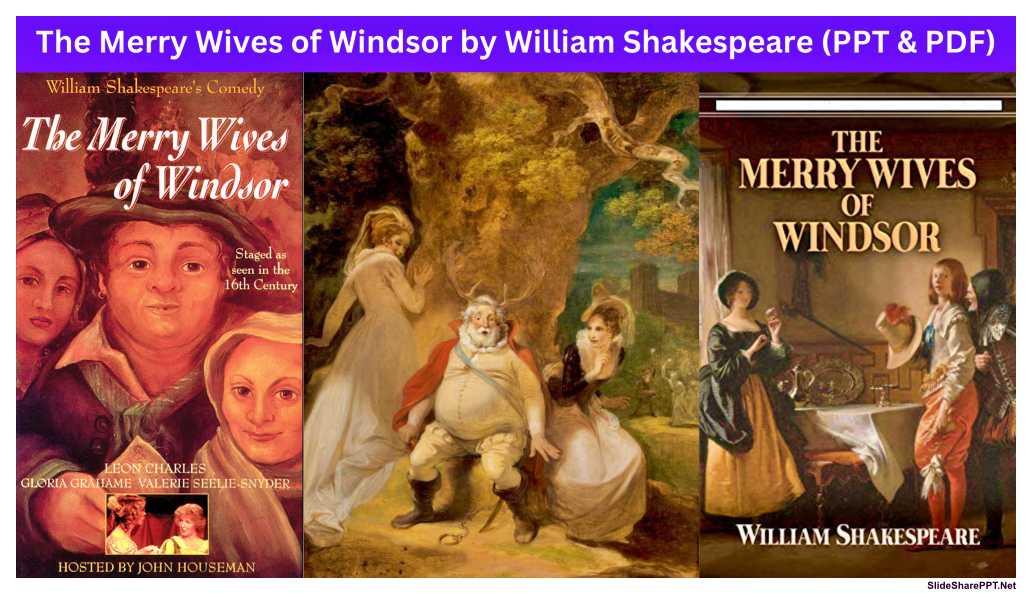
Q&A:
Q: What is the main plot of “The Merry Wives of Windsor”?
A: “The Merry Wives of Windsor” revolves around Sir John Falstaff’s attempts to seduce two wealthy married women, Mistress Ford and Mistress Page, in hopes of obtaining their wealth. However, the clever “merry wives” discover his intentions and devise a series of humorous schemes to outwit him.
Q: How does Shakespeare depict female characters in “The Merry Wives of Windsor”?
A: Shakespeare portrays the female characters in “The Merry Wives of Windsor” as intelligent, witty, and empowered. Mistress Ford and Mistress Page, the titular “merry wives,” take control of their own destinies and assert their agency in a male-dominated society by outsmarting Falstaff and reclaiming their autonomy.
Q: What role does Sir John Falstaff play in the play?
A: Sir John Falstaff serves as a central comedic figure in “The Merry Wives of Windsor.” He is a boastful and larger-than-life character who attempts to seduce Mistress Ford and Mistress Page in pursuit of their wealth. Falstaff’s antics and schemes drive much of the play’s plot and humor.
Q: How does the play explore themes of love and marriage?
A: “The Merry Wives of Windsor” explores themes of love and marriage through the romantic entanglements of its characters. Anne Page’s pursuit of true love and her defiance of her parents’ attempts to arrange a marriage for her highlight the complexities of romantic relationships and societal expectations surrounding marriage.
Q: What makes “The Merry Wives of Windsor” unique among Shakespeare’s works?
A: “The Merry Wives of Windsor” is unique among Shakespeare’s plays as it focuses primarily on domestic comedy without any significant tragic or historical elements. Its lighthearted tone, witty dialogue, and focus on comedic situations make it distinct from Shakespeare’s other works.
Q: Who wrote “The Merry Wives of Windsor”?
A: William Shakespeare wrote “The Merry Wives of Windsor” in the late 16th century, believed to have been first performed in 1597.
Q: Where is the play set?
A: The play is set in the town of Windsor, England.
Q: What is the central plot of “The Merry Wives of Windsor”?
A: The central plot revolves around Sir John Falstaff’s attempts to seduce two wealthy married women, Mistress Ford and Mistress Page, in an effort to solve his financial troubles.
Q: How do Mistress Ford and Mistress Page respond to Falstaff’s advances?
A: Upon discovering Falstaff’s intentions, Mistress Ford and Mistress Page team up to play pranks on Falstaff and expose his deceitful behavior, showcasing their wit and cleverness.
Q: What role do jealousy and insecurity play in the play?
A: Jealousy and insecurity are evident in characters like Ford, who tests his wife’s fidelity out of misguided suspicion and a desire to assert dominance. However, these emotions are ultimately resolved through humor and reconciliation.
Q: Describe the character of Sir John Falstaff.
A: Falstaff is a larger-than-life character known for his roguish charm, wit, and comedic antics. He is also a symbol of human folly and overconfidence, often finding himself in absurd and humorous situations.
Q: What themes are explored in “The Merry Wives of Windsor”?
A: The play explores themes such as love, trust, deception, friendship, gender dynamics, and the power of wit and cleverness over deceit.
Q: How do modern audiences interpret and appreciate “The Merry Wives of Windsor”?
A: Modern audiences often appreciate the play’s timeless humor, witty dialogue, and exploration of complex characters and relationships. Productions may also incorporate contemporary interpretations while retaining the play’s core themes and comedic elements.
Q: What is the significance of the play’s setting in Windsor?
A: The setting in Windsor reflects a middle-class English town, allowing Shakespeare to explore social dynamics, relationships, and societal norms within a familiar context.
Q: How does Shakespeare use language and wordplay in the play?
A: Shakespeare employs clever wordplay, puns, and comedic language throughout the play, enhancing the humor and adding depth to character interactions and situations.
MCQ:
Q: Who is the central character in “The Merry Wives of Windsor”?
a) Sir John Falstaff
b) Mistress Ford
c) Mistress Page
d) Dr. Caius
Answer: a) Sir John Falstaff
Q: In which town is the play “The Merry Wives of Windsor” primarily set?
a) London
b) Windsor
c) Verona
d) Paris
Answer: b) Windsor
Q: What is Falstaff’s motive for trying to seduce Mistress Ford and Mistress Page?
a) To gain political power
b) To solve his financial troubles
c) To seek revenge on their husbands
d) To win a bet with his friends
Answer: b) To solve his financial troubles
Q: How do Mistress Ford and Mistress Page respond to Falstaff’s advances?
a) They accept his proposals.
b) They report him to the authorities.
c) They team up to play pranks on him.
d) They ignore him completely.
Answer: c) They team up to play pranks on him.
Q: What role does jealousy play in the play, particularly in the character of Ford?
a) Ford is jealous of Falstaff’s wealth.
b) Ford is jealous of Mistress Ford’s attention to other men.
c) Ford is jealous of Mistress Page’s social status.
d) Ford is jealous of Falstaff’s friendship with his wife.
Answer: b) Ford is jealous of Mistress Ford’s attention to other men.
Q: Which themes are explored in “The Merry Wives of Windsor”?
a) Love and revenge
b) Deception and betrayal
c) Friendship and loyalty
d) War and politics
Answer: c) Friendship and loyalty
Q: What is the significance of the play’s comedic elements?
a) To highlight the tragedy of human nature
b) To entertain and amuse the audience
c) To criticize societal norms
d) To promote moral values
Answer: b) To entertain and amuse the audience
Q: Which character represents wit, cleverness, and resilience in the play?
a) Sir John Falstaff
b) Justice Shallow
c) Mistress Ford
d) Slender
Answer: c) Mistress Ford
Q: How do modern audiences interpret “The Merry Wives of Windsor”?
a) As a tragedy with dark themes
b) As a historical account of Windsor’s society
c) As a timeless comedy with universal themes
d) As a political commentary on Shakespeare’s era
Answer: c) As a timeless comedy with universal themes
Q: What role does the language and wordplay play in Shakespeare’s “The Merry Wives of Windsor”?
a) It adds complexity to the plot.
b) It confuses the audience.
c) It enhances humor and character interactions.
d) It focuses on dramatic tension.
Answer: c) It enhances humor and character interactions.
Also read: The Merchant of Venice PPT Slides & PDF Download (Complete)
